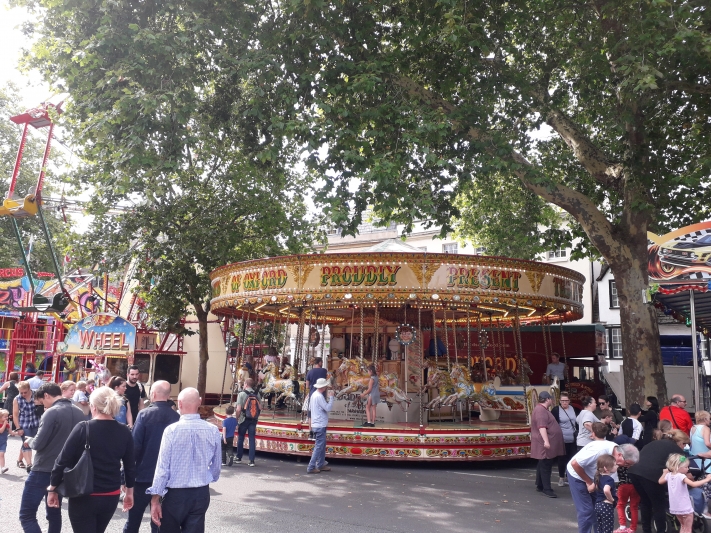
The fair will take place on Monday 8th & Tuesday 9th September 2025
Public transport
Bus and taxi services in St Giles' will be transferred to Broad Street.
Road closures
Road closures and traffic measures will take place in Oxford city centre from 00:01 Sunday 7 September to 8am Wednesday 10 September to manage the safety of pedestrians and vehicles during the fair.
Banbury Road, Beaumont Street, Bevington Road, Keble Road, St Giles, Magdalen Street East and West, Pusey Street, Woodstock Road and Little Clarendon Street will all have some closures.
Disabled Persons parking will be suspended in St Giles, Broad Street, Keble Road and Pusey Street and relocated to Blackhall Road.
Full details can be found on the Oxford County Council webpage.
History of St Giles Fair

Despite how much we like to complain about traffic disruptions, we in Oxford rather like a merry excuse to block off main roads. Witness July's Cowley Road Carnival, and the renowned St Giles Fair, which for two days dominates the thoroughfare at the northern end of the city centre, turning it into a fairground complete with candy floss and assorted hustle and bustle.
As the Fair is a slightly moveable feast, hold onto your hats for the date-calculation details:
"Since the
nineteenth century, St Giles Fair has been held
on the Monday and Tuesday following the first Sunday after St Giles Day (which is always on 1 September). This means that when 1 September is a Saturday, the fair is held at the earliest possible time; but when 1 September is a Sunday, the fair is held at the latest possible time."
Queen Elizabeth I was in attendance in 1567, though sadly not in the thick of the action on a waltzer. Rumour has it that she viewed the revelry from the comfort of St John's College rooms. Sceptics note that this was still a few decades before the first recorded Fair. But as films like
Shakespeare in Love have shown us, monarchs got up to all sorts.
Non-genteel entertainments, some of the attractions wouldn't be out of place on Coney Island. The Oxford Chronicle of 1889 goes into great detail describing the novelty of a thirty-foot high zipwire! After harmless rides and good times had by all, the ride was deemed unsuitable for females. The fair's un-PC history was to continue. The area turned into a zoo as Day's Menagerie brought five hundred exotic animals such as lions, tigers, vultures and wild wolves; you could also enjoy various mind-readers and a guy shooting fruit off a lady's head (with permission).
John Betjeman wrote about the Fair in the 1930s, reckoning it the largest fair in England, and reporting on the still-prevalent freak-shows. We find it surprising that such exploitative 'entertainments' persisted that far into UK history, but extant culture confirms it. A fictional 'freak' appears in publicity for St Giles Fair in Stravinsky's
The Rake's Progress; our titular anti-hero marries Baba the Turk, the starlet with a heart of gold and a beard of great size.
At the records of flip-flaps, Thurston's Bioscope and some flying pigs, I had to stop reading in incomprehension and mild jealousy at how much fun it would've been. There are plenty of great stories and records and the Pitt Rivers Museum holds some artefacts from the fair, including publicity for a renowned flea circus. Have a look at
Oxford History for a selection.
So where did it all begin? Parish councils instituted 'wakes' to help communities have fun. And this one was attached to the Saint's day of the parish church which gave the street its name. Organised fun? Why not?!
The earliest record of the Fair comes thanks to an incident in the Session Rolls of James I, in which someone swore "six insufferable oaths" and got fined. A historically useful application of swearing, then. At this point it was still known as the Wake, later as the Feast, and finally in the late 18th Century, a Fair, due to the toys on display and for sale. By the time rides and amusements for adults were involved, public lairiness increased until some called for the Fair to be discontinued. Fortunately it survived through Victorian times, when cross-country travel allowed day-trippers to visit from as far afield as Wales.
For those interested in matters of
practicality: "The present fair is organised by Oxford Council in association with the London and Home Counties Section of the Showmen's Guild of Great Britain. The rights to hold the fair at St. Giles are shared between St. John the Baptist College Oxford and the local council."
After an opening by the Lord Mayor on the Monday morning, there are plenty of mechanical means of being flung around at altitude, a fun house unfortunately not hosted by Pat Sharp, and gentler attractions for the younger kids. 6pm customarily brings a slight price increase, though. If fluorescent lights and vertiginous drops leave you in need of some 'introvert-time', St Giles Church is usually open to provide refreshments and sanctuary. 2018 sees the debut of the Double Decker Bus Bar alongside the other food and drink stalls.
Thus the annual celebration endures. Even the first Fair after the outbreak of WWI, attended by many khaki-clad soldiers, was described in the Oxford Chronicle as follows:
"Despite the chilling influences of the war on pleasure, despite a restriction on hours, St. Giles Fair is still going strong. If they had the power to stop it, the City Council would have probably have done so. But the masses of the people in Oxford and the surrounding country districts are evidently as attached to the Fair as ever and it has rarely been more crowded"
-
Oxford Chronicle, reported in The World's Fair, 19 September, 1914.
For more information, have a look at the Oxford City Council webpage.





